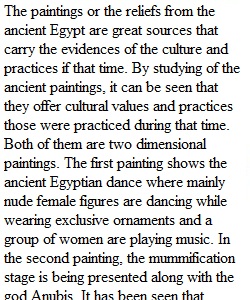


Q Walk Like an Egyptian Artistic license was hardly an accepted idea in ancient Egypt. For roughly 3,000 years, style conventions for rendering the human body were based on persistent tradition. However, these conventions were altered briefly during the 14th century Amarna Period under the ruler Akhenaten. The purpose of this activity is to explore the traditional style conventions for Egypt and the surprising style aberrations that occurred during Akhenaten’s time. Here is what you are to do for this assignment: 1. First, begin by searching the book or the Internet for two free-standing figures, two paintings, or two reliefs from ancient Egypt. Carefully examine and study the pair. o As you are doing so, take note of the style qualities that were Egyptian conventions for 2-dimensional, 3-dimensional, or relief figures. Compare the two for style similarities they share. Remember to concentrate on style, not subject similarities in your descriptions. 2. Then, in a substantial paragraph, discuss the style qualities the pair share and describe the style conventions as you see them. o How are humans rendered, and does the social status of the figure make a difference in the portrayal? 3. Your next step is to introduce one work produced during the time of Akhenaten. Analyze your sample for style. o Discuss, in one paragraph, how artistic conventions were altered during the reign of King Akhenaten. Address what you feel may be an explanation for this deviation from traditional style. After reading through the posts of your peers, choose two, and respond with whether you agree with each peer’s analysis. Include why or why not.
View Related Questions